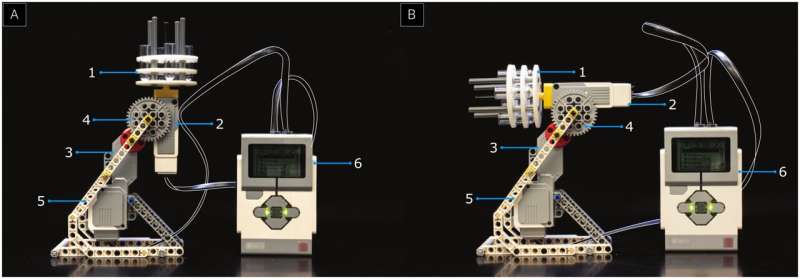July 20, 2023 report
This article has been reviewed according to Science X's editorial process and policies. Editors have highlighted the following attributes while ensuring the content's credibility:
fact-checked
peer-reviewed publication
trusted source
proofread
Using a LEGO robot as a gradient mixer to purify DNA origami nanostructures

A team of bioengineers at Arizona State University has found a way to use a LEGO robot as a gradient mixer in one part of a process to create DNA origami nanostructures. In their paper published on the open-access site PLOS ONE, the group describes how they made their mixer and its performance.
To create DNA origami structures, purification of DNA origami nanostructures is required. This is typically done using rate-zone centrifugation, which involves the use of a relatively expensive piece of a machinery, a gradient mixer. In this new effort, the team at ASU has found that it is possible to build such a mixer using off-the-shelf LEGO kits.
Gradient mixers work by spinning material inside of cylindrical tubes—but they require a way to pour ingredients into the tubes. Thus, at the outset, the tubes must be positioned vertically. Then, once caps are placed on the tops to prevent spilling, the tubes are moved into a horizontal position and are then spun. This separates the material in the liquid into a gradient.
To make a LEGO robot gradient mixer, the team started with a simple base and built a single-arm robot on top of it. The arm holds and guides a platform to which the tubes can be connected. As with the commercial version, once the tubes are filled and capped, the robot arm spins the tubes slowly to mix the contents. It then lowers the tubes into a vertical position and spins them rapidly.
Testing showed that the robot was able to mix and separate the required materials as well as commercial versions, though it cost considerably less. The research team notes that the entire mixer, including the two motors (one for placement, the other for spinning), was made only of LEGO parts except the tube holder—they made that using a 3D printer.
The research team suggest that not only can their LEGO robot be used as a gradient mixture in real world applications; it shows that many other expensive lab machines might be made using a similar approach.
More information: Jason Sentosa et al, Gradient-mixing LEGO robots for purifying DNA origami nanostructures of multiple components by rate-zonal centrifugation, PLOS ONE (2023). DOI: 10.1371/journal.pone.0283134
Journal information: PLoS ONE
© 2023 Science X Network





















